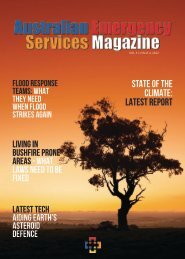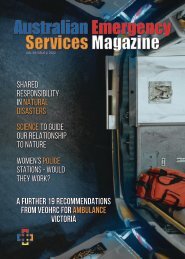Vol. 13 Issue 3. 2019
• Latest Events • Emergency Law with Prof. Michael Eburn • Friendships & Career in the Emergency Sector • Technology changing Police Surveillance • Natural Disasters & Mental Health • Click image to read more......
• Latest Events • Emergency Law with Prof. Michael Eburn • Friendships & Career in the Emergency Sector • Technology changing Police Surveillance • Natural Disasters & Mental Health • Click image to read more......
Create successful ePaper yourself
Turn your PDF publications into a flip-book with our unique Google optimized e-Paper software.
AUSTRALIAN EMERGENCY LAW with Professor Michael Eburn<br />
A DISCUSSION ON<br />
THE LAW THAT<br />
APPLIES TO OR<br />
AFFECTS AUSTRALIA’S<br />
EMERGENCY<br />
SERVICES AND<br />
EMERGENCY<br />
MANAGEMENT<br />
PHD<br />
Barrister<br />
Leading expert in Law<br />
relating to Emergency<br />
Management &<br />
Emergency Services<br />
Follow Michael Eburn<br />
Facebook- facebook.com/EburnM/<br />
Twitter - @EburnM<br />
For his latest articles on Emergency<br />
Law go to:<br />
www.emergencylaw.wordpress.com<br />
Prevent or Respond ?<br />
A question for Emergency Services<br />
The mantra is Prevent, Prepare,<br />
Respond and Recovery.<br />
Preventing an emergency is better<br />
than responding to one; but equally<br />
we want resilient communities where<br />
individuals and communities take<br />
responsibility for managing their<br />
own risk. But that still leaves the<br />
emergency services to respond if and<br />
when the residual risk manifests.<br />
So where does the role of the<br />
emergency services sit when it comes<br />
to ‘prevent’? That is the essence of<br />
today’s question that comes from<br />
Adelaide. My correspondent has<br />
noticed:<br />
A large tree is growing in one of<br />
the private residences, right on the<br />
edge, literally, of a lane – there is no<br />
footpath. This tree has a diameter<br />
at the base of abut 1.5 metres and a<br />
height of, maybe, 30 to 40 metres – I.e.<br />
a ‘significant’ tree. A broken branch<br />
was lying across two other branches<br />
at a height of 15 to 20 metres. The<br />
butt of the branch was about a metre<br />
into the lane on the tree side and the<br />
branch extended across the lane and<br />
finished about 2 to 3 metres over the<br />
first-floor open car park area of a<br />
business on the other side. It had been<br />
there for some time because the leaves<br />
were dead.<br />
I advised the resident in the house<br />
and she said that she would inform<br />
the owner (she is renting). I advised<br />
the business on the other side and the<br />
receptionist said that she would notify<br />
the council, which I had intended to<br />
do, as well.<br />
Jan 29, <strong>2019</strong><br />
As an SES volunteer, I also called it in<br />
to the SES reporting line. In Adelaide,<br />
these calls go the MFS call centre. After<br />
I explained the situation, the call-taker<br />
said that it was not their responsibility;<br />
it was the responsibility of the landowner.<br />
I knew that it was too high for<br />
SES to handle, but the MFS has aerial<br />
units that would reach it and I thought<br />
that they may respond.<br />
I suspect that it is the responsibility of<br />
the land-owner, but is this the case?<br />
Would it constitute enough of a risk for<br />
emergency services to be involved?<br />
The problem is, in essence, that the<br />
emergency services legislation says<br />
very little about what the emergency<br />
services do. It may be axiomatic that<br />
fire brigades respond to fires so if<br />
there is a fire everyone knows that<br />
it’s the fire service job. And the fire<br />
brigades have specific duties and<br />
powers with respect to preventing<br />
fires (see Fire And Emergency<br />
Services Act 2005 (SA) ss 71-95A and<br />
ss 105A-105K (relating to the Country<br />
Fire Service)). But for other hazards<br />
the issues are not so clear.<br />
The South Australian State<br />
Emergency Service has a number<br />
of functions relating to dealing<br />
with emergencies, including ‘to<br />
assist the State Co-ordinator, in<br />
accordance with the State Emergency<br />
Management Plan, in carrying out<br />
prevention, preparedness, response<br />
or recovery operations under the<br />
Emergency Management Act 2004’ (s<br />
108(1)(b); emphasis added); and ‘to


















